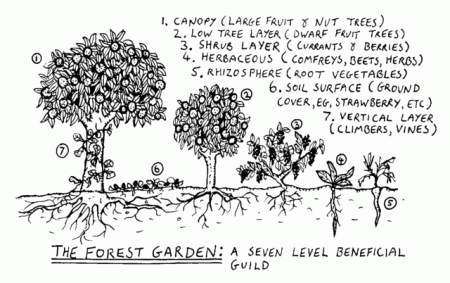By Brett Nathan
Permaculture is a design method focused on agriculturally productive systems. The word ‘permaculture’ is a portmanteau of ‘permanent agriculture’, and was conceived in 1978 by Bill Mollison and David Holmgren in Tasmania with the publication of Bill’s book Permaculture One. The text was the result of their research into the sustainability of traditional cultures from around the globe, with a focus on practices of cultures that co-exist with nature. This was in stark contrast to a fossil fuel hungry modern civilization, less than two centuries old and already wreaking devastating environmental havoc.
Through this study they saw a beacon of hope. By observing natural systems and recognizing their patterns and interactions we can start to mimic nature. If we can recognize the patterns that nature wants to use, we can interact and perhaps reduce the distance between what we consume and where it is produced. Working with nature, in this grassroots sense, is more efficient than industrial processes.
“The philosophy behind permaculture is one… of looking at systems in all their functions, rather than asking only one yield of them; and allowing systems to demonstrate their own evolutions,” Bill Mollison.
People who are already familiar with permaculture might initially think of crop rotating, or other methods commonly associated with organic farming. Permaculture goes beyond conventional farming, organic or industrial, to really design systems that function toward bettering more than just a single aspect of the system.
Any truly sustainable system, according to permaculture, needs to abide by a simple three-pronged ethic:
1. Care of Earth
2. Care of People
3. Share of Surplus/Make no waste
If we think about these ethics in nature it is easy to think of examples of how within a mature eco-system there is no waste. No one species (bar the obvious, but debatable, exception of humans) dominates for very long and there is always an element to bring other things into balance.
This principle can be used when trying to deal with pests in a garden. Let’s say the biological community of the forest is regulated by the predator-prey relationship. By abiding by this natural predator-prey relationship, we might witness a growth in population of one bug, which elicits predator attention that then they come in and regulate the population. If we spray chemicals to get rid of the bugs, this does not stop that cycle from repeating. The predators never find the bugs in that particular area, and so your environment doesn’t build that resistance.
Permaculture takes the idea of a self-correcting mechanics of natural processes from the Gaiaa hypothesis, James Lovelocks sentient earth theory. The organisms on the planet are seen as being the body of earth. It could be said that humans have taken to the planet like a virus takes to a body.
These corrective measures, work within soil as well in ecosystems. When applying chemicals to the environment it is similar to adding particular minerals to the soil. In too large a quantity, the addition of particular minerals can reduce or completely block the uptake of other minerals. This mechanism allows the soil its makeup in the pattern of direction that environment is going. We must not start to think that the only types of places we find healthy systems are where there are a balance of elements. Rather we must consider that an imbalance in a system comes from an element that is working against the local pattern. This means, that if an area is turning from grassland into a forest, then the elements that are facilitating that change are elements that nature and we would want to stay in play.
So what can we learn from permaculture? And even more, what can we learn from permaculture that maybe resonates from within our tradition? That is where the permaculture journey began, looking at methods that were developed and maintained through the course of the birthing of cultures.
Thinking in this vain, the Jewish tradition has a lot to share. From the shmai drawing its connections between honoring G-d and the abundance of the land to a broader acknowledgement of the agricultural year within the Jewish year. This cycle is related to a large pattern in nature. If we want to extend this agricultural year into our lives it might help us to live more consciously aware of how the land and our life on this planet are connected. Whether we agree with how permaculture sees sustainability, we might need to heed its warning to become better observers of the world in which we live.
Brett’s permaculture interests stem from a simple question, does environmental practice = sustainable practice?
Headline diagram by Graham Burnett.
Permaculture – Informed by Ancient Culture

